Investigation on Aesthetic and Water Permeability of Surface Protective Material under Accelerated Weathering
Abstract
1. Introduction
2. Materials and Methods
2.1. Materials
2.2. Specimens
2.3. Surface Treatments
2.4. Accelerated Weathering (Weathering to Xenon-Arc Radiation)
2.5. Appearance Change
2.5.1. Visual Observation
2.5.2. Color Differences
2.5.3. Gloss
2.5.4. Roughness
2.5.5. Contact Angle
2.6. Water Absorption Test
2.7. Moisture Permeability Test
2.8. Anti-Soiling Test
2.8.1. Visual Observation
2.8.2. Color Difference
2.8.3. Pollution Average Width
3. Results and Discussions
3.1. Visual Observation
3.2. Brightness
3.3. Gloss
3.4. Roughness
3.5. Contact Angle
3.6. Water Absorption Test
3.7. Moisture Permeability Test
3.8. Anti-Soiling Test
3.8.1. Visual Observation
3.8.2. Pollution Average Width
3.8.3. Brightness Difference
4. Conclusions
Author Contributions
Funding
Institutional Review Board Statement
Informed Consent Statement
Data Availability Statement
Acknowledgments
Conflicts of Interest
References
- Holmes, N.; Browne, A.; Montague, C. Acoustic properties of concrete panels with crumb rubber as a fine aggregate replacement. Constr. Build. Mater. 2014, 73, 195–204. [Google Scholar] [CrossRef]
- Freedman, S. Loadbearing architectural precast concrete wall panels. PCI J. 1999, 44, 92–115. [Google Scholar] [CrossRef]
- López, A.; Guzmán, A.; Di Sarli, A.R. Color stability in mortars and concretes. Part 2: Study on architectural concretes. Constr. Build. Mater. 2016, 123, 253–284. [Google Scholar] [CrossRef]
- Chang, H.; Wang, P.; Jin, Z.; Li, G.; Feng, P.; Ye, S.; Liu, J. Durability and Aesthetics of Architectural Concrete under Chloride Attack or Carbonation. Materials 2020, 13, 839. [Google Scholar] [CrossRef]
- Simpson, J.W.; Horrobin, P.J. The Weathering and Performance of Building Materials; Department of Building, University of Manchester Institute of Science and Technology: Manchester, UK, 1970. [Google Scholar]
- NF EN 1504. Products and Systems for the Protection and Repair of Concrete Structures, European Standard; AFNOR Publishing: St Malo, France, 2005. [Google Scholar]
- Christodoulou, C.; Goodier, C.I.; Austin, S.A.; Webb, J.; Glass, G.K. Long-term performance of surface impregnation of reinforced concrete structures with silane. Constr. Build. Mater. 2013, 48, 708–716. [Google Scholar] [CrossRef]
- Almusallam, A.A.; Khan, F.M.; Dulaijan, S.U.; Al-Amoudi, O.S.B. Effectiveness of surface coatings in improving concrete durability. Cem. Concr. Compos. 2003, 25, 473–481. [Google Scholar] [CrossRef]
- Ivanovna, L.V. Forecasting the durability of coatings. In Increasing the Durability of Paint and Varnish Coatings in Building Products and Construction; Woodhead Publishing Series in Civil and Structural Engineering; Woodhead Publishing: Sawston, UK, 2019; pp. 93–132. [Google Scholar]
- Garrido, M.A.; Paulo, P.V.; Branco, A.F. Service life prediction of façade paint coatings in old buildings. Constr. Build. Mater. 2012, 29, 394–402. [Google Scholar] [CrossRef]
- Creasey, R.; Andrews, J.P.; Ekolu, S.O.; Kruger, D. Long-term 20-year performance of surface coating repairs applied to façades of reinforced concrete buildings. Case Stud. Constr. Mater. 2017, 7, 348–360. [Google Scholar] [CrossRef]
- Perera, D.Y. Physical ageing of organic coatings. Prog. Org. Coat. 2003, 47, 161–176. [Google Scholar] [CrossRef]
- Jacques, L.F.E. Accelerated and outdoor/natural exposure testing of coatings. Prog. Polym. Sci. 2000, 25, 1337–1362. [Google Scholar] [CrossRef]
- Basheer, L.; Cleland, D.J. Durability and water absorption properties of surface treated concretes. Mater. Struct. 2011, 44, 957–967. [Google Scholar] [CrossRef]
- Basheer, P.A.M.; Basheer, L.; Cleland, D.J.; Long, A.E. Surface treatments for concrete: Assessment methods and reported performance. Constr. Build. Mater. 1997, 11, 413–429. [Google Scholar] [CrossRef]
- Moradllo, M.K.; Shekarchi, M.; Hoseini, M. Time-dependent performance of concrete surface coatings in tidal zone of marine environment. Constr. Build. Mater. 2012, 30, 198–205. [Google Scholar] [CrossRef]
- Dang, Y.; Xie, N.; Kessel, A.; McVey, E.; Pace, A.; Shi, X. An accelerated laboratory evaluation of surface treatments for protecting concrete bridge decks from salt scaling. Constr. Build. Mater. 2014, 55, 128–135. [Google Scholar] [CrossRef]
- Norvaišienė, R.; Burlingis, A.; Stankevičius, V. Durability tests on painted facade rendering by accelerated ageing. Mater. Sci. 2010, 16, 80–85. [Google Scholar]
- Hua, J.W.; Li, X.G.; Gao, J.; Zhao, Q.L. UV aging characterization of epoxy varnish coated steel upon weathering to artificial weathering environment. Mater. Des. 2009, 30, 1542–1547. [Google Scholar] [CrossRef]
- De Vries, J.; Polder, R.B. Hydrophobic treatment of concrete. Constr. Build. Mater. 1997, 11, 259–265. [Google Scholar] [CrossRef]
- Thompson, J.L.; Silsbee, M.R.; Gill, P.M.; Scheetz, B.E. Characterization of silicate sealers on concrete. Cem. Concr. Res. 1997, 27, 1561–1567. [Google Scholar] [CrossRef]
- Aguiar, J.L.; Camões, A.; Moreira, P. Performance of concrete in aggressive environment. Int. J. Concr. Struct. Mater. 2008, 2, 21–25. [Google Scholar]
- Graziani, L.; Quagliarini, E.; Bondioli, F.; D’Orazio, M. Durability of self-cleaning TiO2 coatings on fired clay brick façades: Effects of UV weathering and wet & dry cycles. Build. Environ. 2014, 71, 193–203. [Google Scholar]
- Grüll, G.; Tscherne, F.; Spitaler, I.; Forsthuber, B. Comparison of wood coating durability in natural weathering and artificial weathering using fluorescent UV-lamps and water. Eur. J. Wood Wood Prod. 2014, 72, 367–376. [Google Scholar] [CrossRef]
- Williams, R.S.; Knaebe, M.; Sotos, P. Effect of surface preparation on service life of top coats applied to weathered primer paint. In Proceedings of the PRA’s 6th International Woodcoatings Congress, Amsterdam, The Netherlands, 14–15 October 2018. [Google Scholar]
- Marsich, L.; Ferluga, A.; Cozzarini, L.; Caniato, M.; Sbaizero, O.; Schmid, C. The effect of artificial weathering on PP coextruded tape and laminate. Compos. Part A Appl. Sci. Manuf. 2017, 95, 370–376. [Google Scholar] [CrossRef]
- Franzoni, E.; Sassoni, E.; Scherer, G.W.; Naidu, S. Artificial weathering of stone by heating. J. Cult. Herit. 2013, 14S, e85–e93. [Google Scholar] [CrossRef]
- Sassoni, E.; Naidu, S.; Scherer, G.W. The use of hydroxyapatite as a new inorganic consolidant for damaged carbonate stones. J. Cult. Herit. 2011, 12, 346–355. [Google Scholar] [CrossRef]
- JIS K 5600-7-7:2008 (ISO 1134: 2004). Testing Methods for Paints—Part 7: Long-Period Performance of Film—Section 7: Accelerated Weathering and Weathering to Artificial Radiation (Weathering to Filtered Xenon-Arc Radiation); Japanese Standards Association: Tokyo, Japan, 2008. [Google Scholar]
- JIS K 5600-8-1~6:2014. Testing Methods for Paints-Part 8: Evaluation of Degradation of Coatings-Designation of Quantity and Size of Defects, and of Intensity of Uniform Changes in Appearance-Section 1: General Principles and Rating Schemes; Japanese Standards Association: Tokyo, Japan, 2014. [Google Scholar]
- JIS K 5600-4-6:1999. Testing Methods for Paints−Part 4: Visual Characteristics of Film−Section 6: Colorimetry (Calculation of Colour Differences); Japanese Standards Association: Tokyo, Japan, 1999. [Google Scholar]
- JIS K 5600-4-7:1999. Testing Methods for Paints−Part 4: Visual Characteristics of Film−Section 7: Specular Gloss; Japanese Standards Association: Tokyo, Japan, 1999. [Google Scholar]
- JIS B 0601-2001. Definitions and Designation of Rolling Circle Waviness; Japanese Standards Association: Tokyo, Japan, 2001. [Google Scholar]
- NSKS-004. Penetration Type Water Absorption Prevention Materials; Japan Building Coating Materials Association: Tokyo, Japan, 1992. [Google Scholar]
- JSCE-K571-2005. Test Methods of Surface Penetrants for Concrete Structures; Japan Society of Civil Engineers: Tokyo, Japan, 2005. Available online: http://www.jsce.or.jp/committee/concrete/e/newsletter/newsletter11/Contents.pdf (accessed on 1 September 2021).
- Construction Technology Development Committee. Nikkenren-Type Coating Material Accelerated Pollution Test Method; Japan Federation of Construction Contractors: Tokyo, Japan, 2017. [Google Scholar]
- Tao, H.; Tang, Y. The research progress of silicone compounds in protection of stony historic relics. Paint. Coat. Ind. 2010, 40, 74–79. [Google Scholar]
- Pigino, B.; Leeman, A.; Franzoni, E.; Lura, P. Ethyl silicate for surface treatment of concrete—Part II: Characteristics and performance. Cem. Concr Compos 2012, 34, 313–321. [Google Scholar] [CrossRef]
- Yuan, J.; Gang, L. Fabrication and structural characterization of poly(vinylidene fluoride)/polyacrylate composite waterborne coatings with excellent weather resistance and room-temperature curing. Colloids Surf. A Physicochem. Eng. Asp. 2020, 598, 124851. [Google Scholar]
- Wood, K.A.; Cypcar, C.; Hedhli, L. Predicting the exterior durability of new fluoropolymer coatings. J. Fluor. Chem. 2000, 104, 63–71. [Google Scholar] [CrossRef]
- Sung, L.-P.; Vicini, S.; Ho, D.L.; Hedhli, L.; Olmstead, C.; Wood, K.A. Effect of microstructure of fluorinated acrylic coatings on UV degradation testing. Polymer 2004, 45, 6639–6646. [Google Scholar] [CrossRef]
- Franzoni, E.; Pigino, B.; Pistolesi, C. Ethyl silicate for surface protection of concrete: Performance in comparison with other inorganic surface treatments. Cem. Concr. Compos. 2013, 44, 69–76. [Google Scholar] [CrossRef]
- De Haan, J.W.; van den Bogaert, H.M.; Ponjee, J.J.; van de Ven, L.J.M. Characterization ofmodified silica powders by Fourier transform infrared spectroscopy and cross-polarization magic angle spinning NMR. J. Colloid Interface Sci. 1986, 110, 591–600. [Google Scholar] [CrossRef][Green Version]
- Bauer, F.; Decker, U.; Dierdorf, A.; Ernst, H.; Heller, R.; Liebe, H.; Mehnert, R. Preparation of moisture curable polysilazane coatings: Part I. Elucidation of low temperature curing kinetics by FT-IR spectroscopy. Prog. Org. Coat. 2005, 53, 183–190. [Google Scholar] [CrossRef]
- Zhao, H.; Richards, B.T.; Levi, C.G.; Wadley, H.N.G. Molten silicate reactions with plasma sprayed ytterbium silicate coatings. Surf. Coat. Technol. 2016, 288, 151–162. [Google Scholar] [CrossRef]
- Charola, A.E.; Rodrigues, J.D.; Anjos, M.V. An unsatisfactory case of water repellents applied to control biomineralization. In Proceedings of the Hydrophobe V. 5th International Conference on Water Repellent Treatment of Building Materials; Aedificatio: Freiburg, Germany, 2008; Available online: https://repository.si.edu/bitstream/handle/10088/38362/Charola%20et%20al.%20Queluz%20Hydrophobe%20V%202008.pdf (accessed on 1 September 2021).
- Ganesh, V.A.; Raut, H.K.; Nair, A.S.; Ramakrishna, S. A review on self-cleaning coatings. J. Mater. Chem. 2011, 21, 16304. [Google Scholar] [CrossRef]
- Wang, R.; Hashimoto, K.; Fujishima, A.; Chikuni, M.; Kojima, E.; Kitamura, A.; Shimohigoshi, M.; Watanabe, T. Light-induced amphiphilic surfaces. Nature 1997, 388, 431–432. [Google Scholar] [CrossRef]
- Fujishima, A.; Zhang, X. Titanium dioxide photocatalysis: Present situation and future approaches. Comptes Rendus Chim. 2006, 9, 750–760. [Google Scholar] [CrossRef]
- Diamanti, M.V.; Paolini, R.; Rossini, M.; Aslan, A.B.; Zinzi, M.; Poli, T.; Pedeferri, M.P. Long term self-cleaning and photocatalytic performance of anatase added mortars exposed to the urban environment. Constr. Build. Mater. 2015, 96, 270–278. [Google Scholar] [CrossRef]

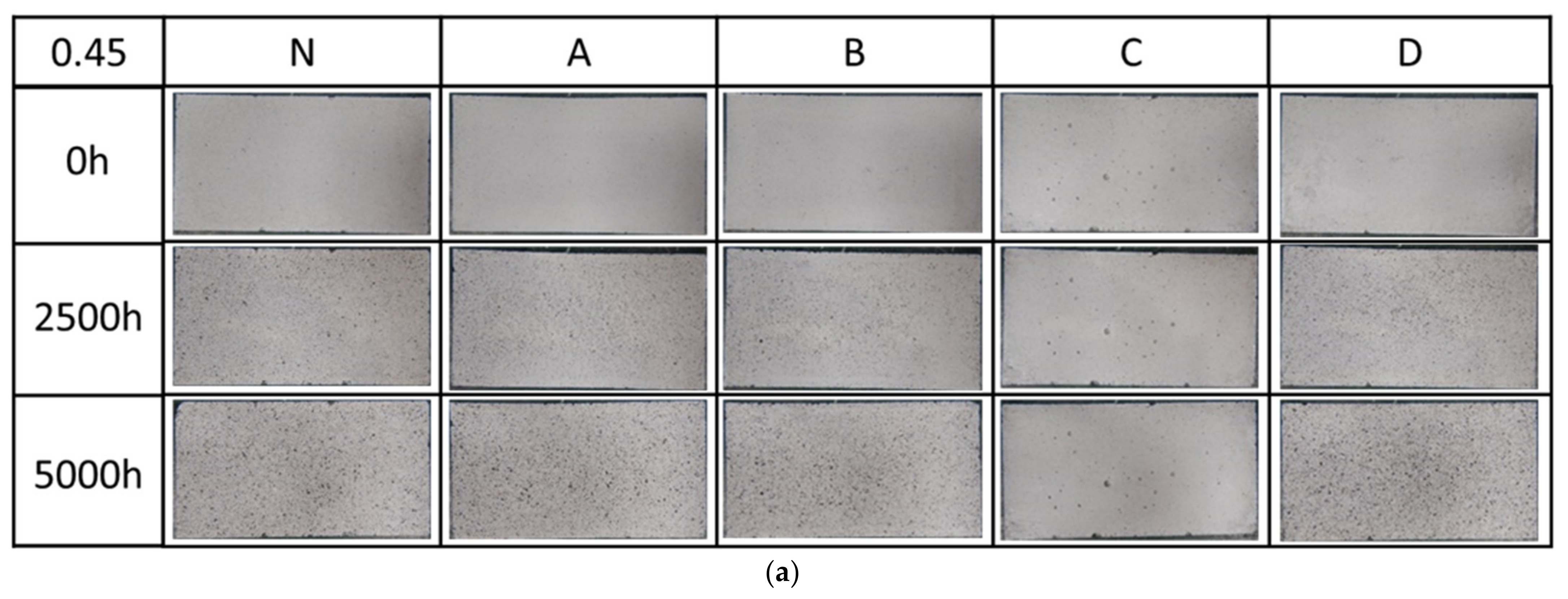
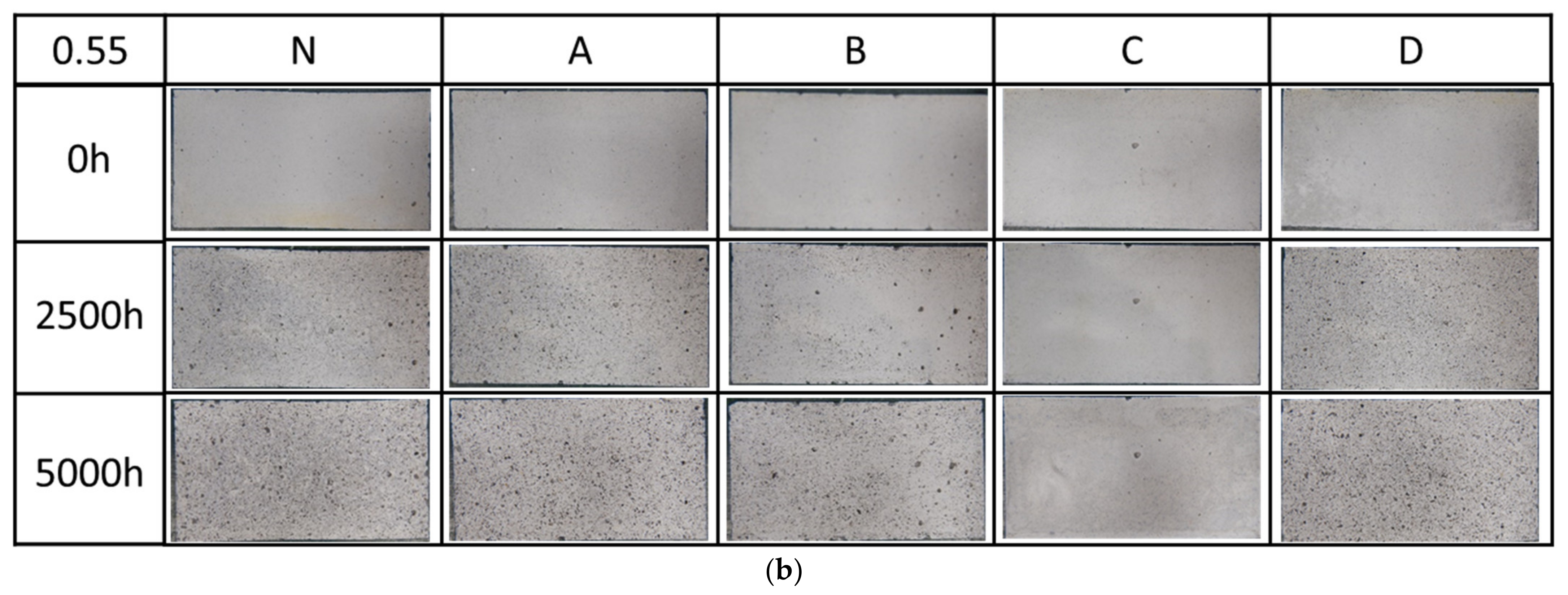
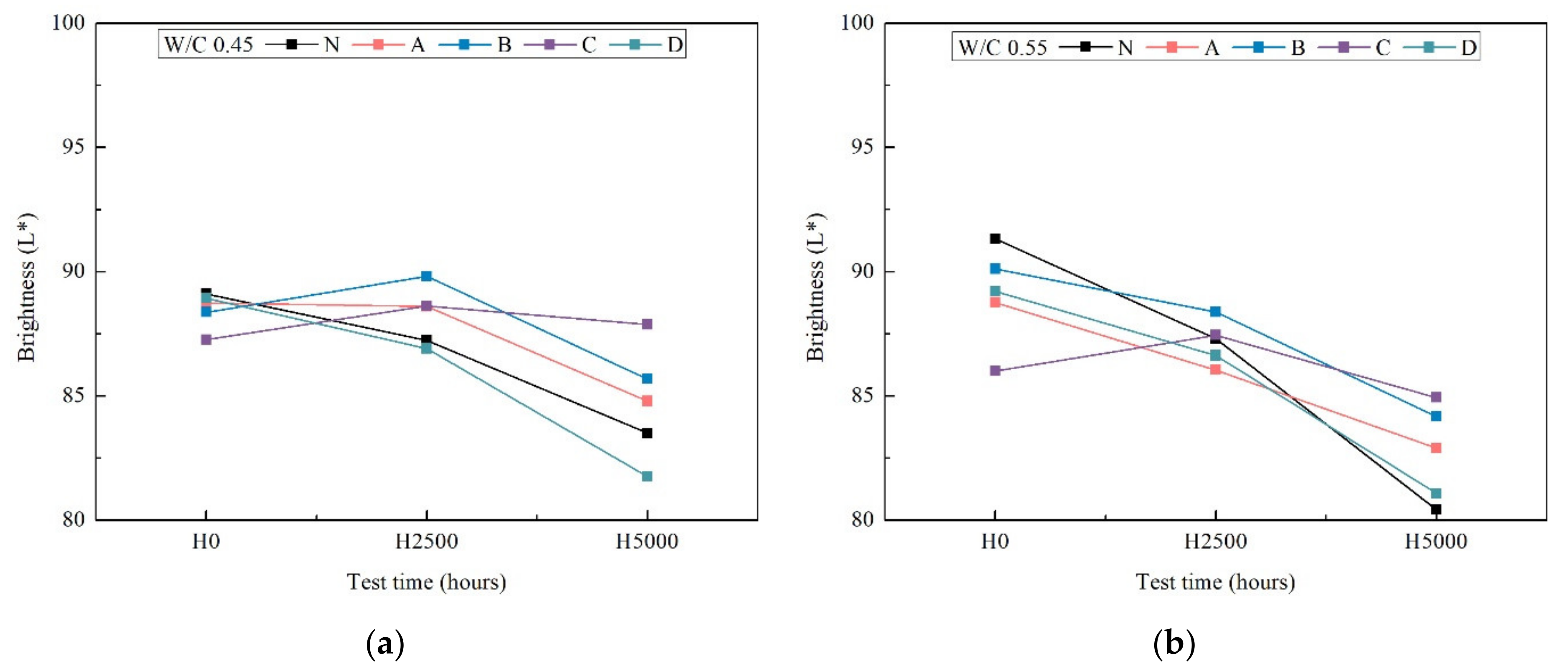


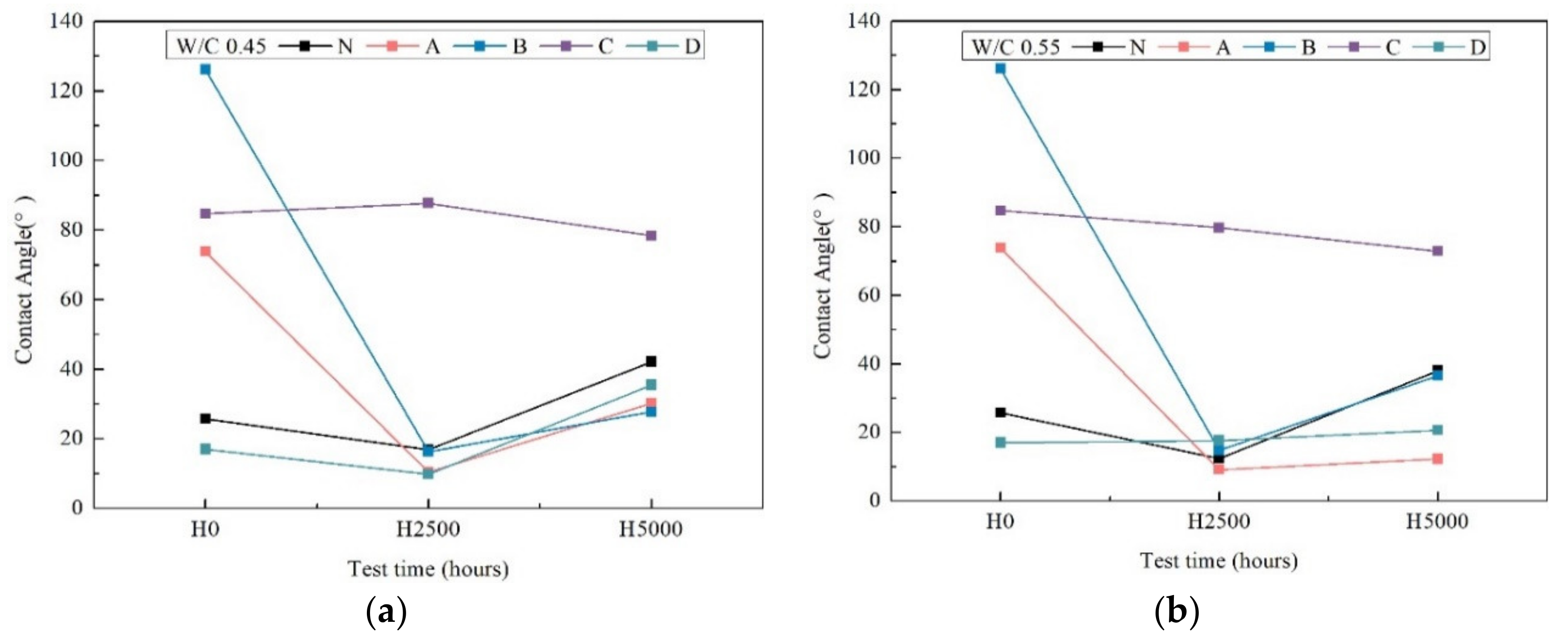
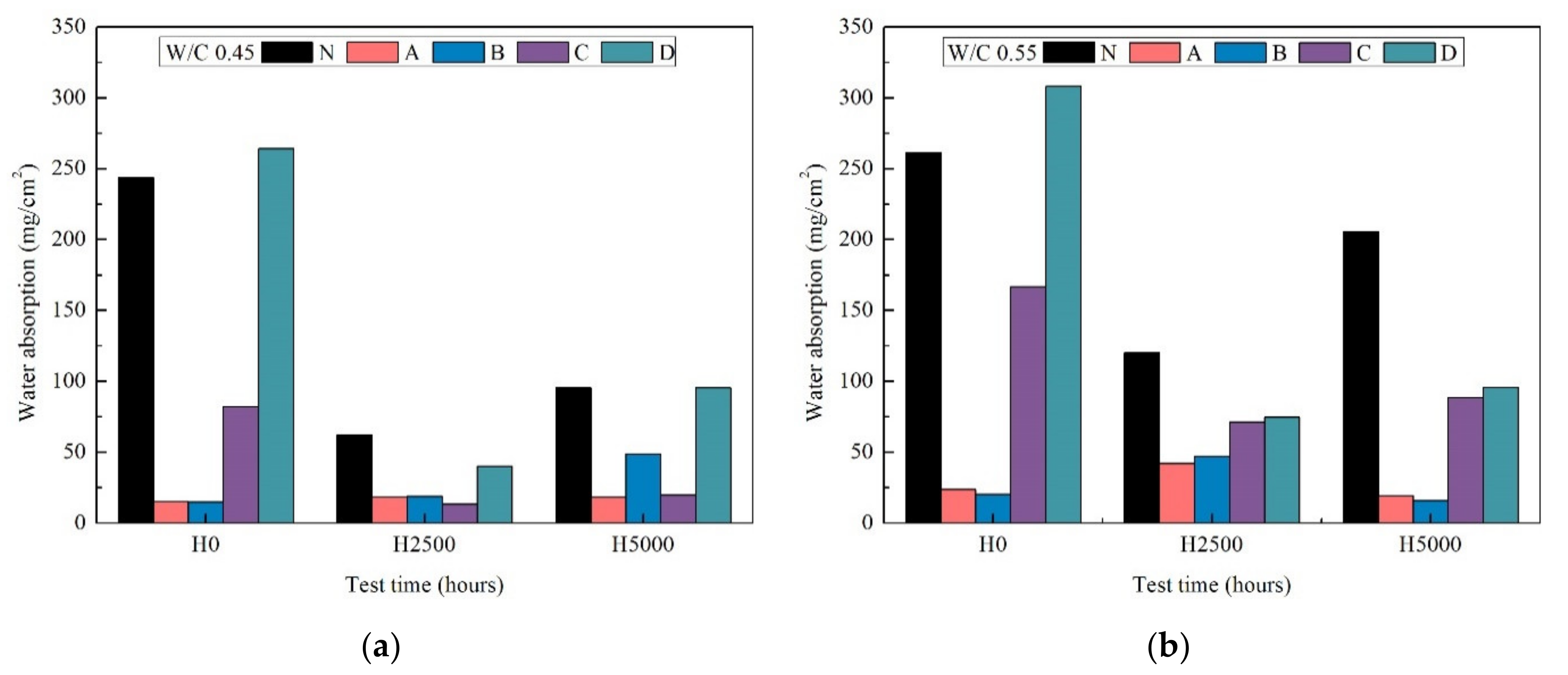
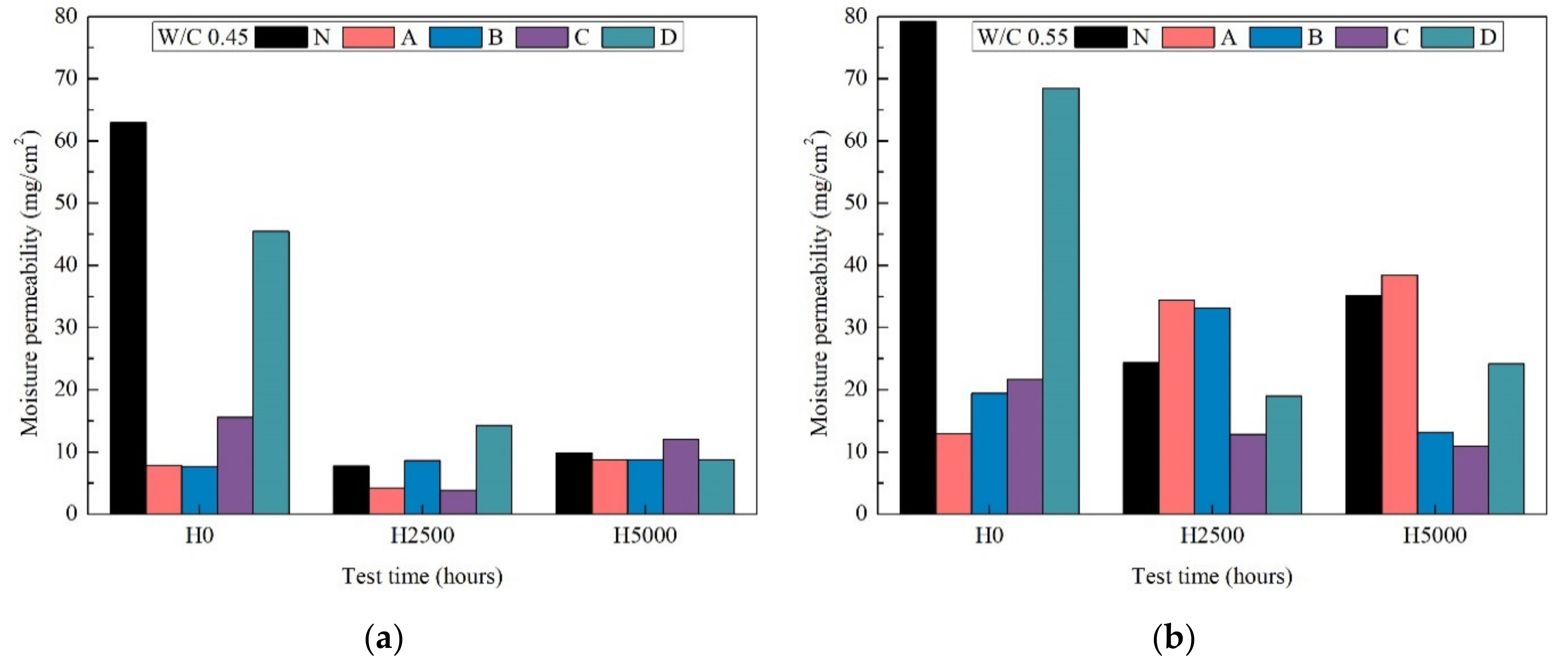
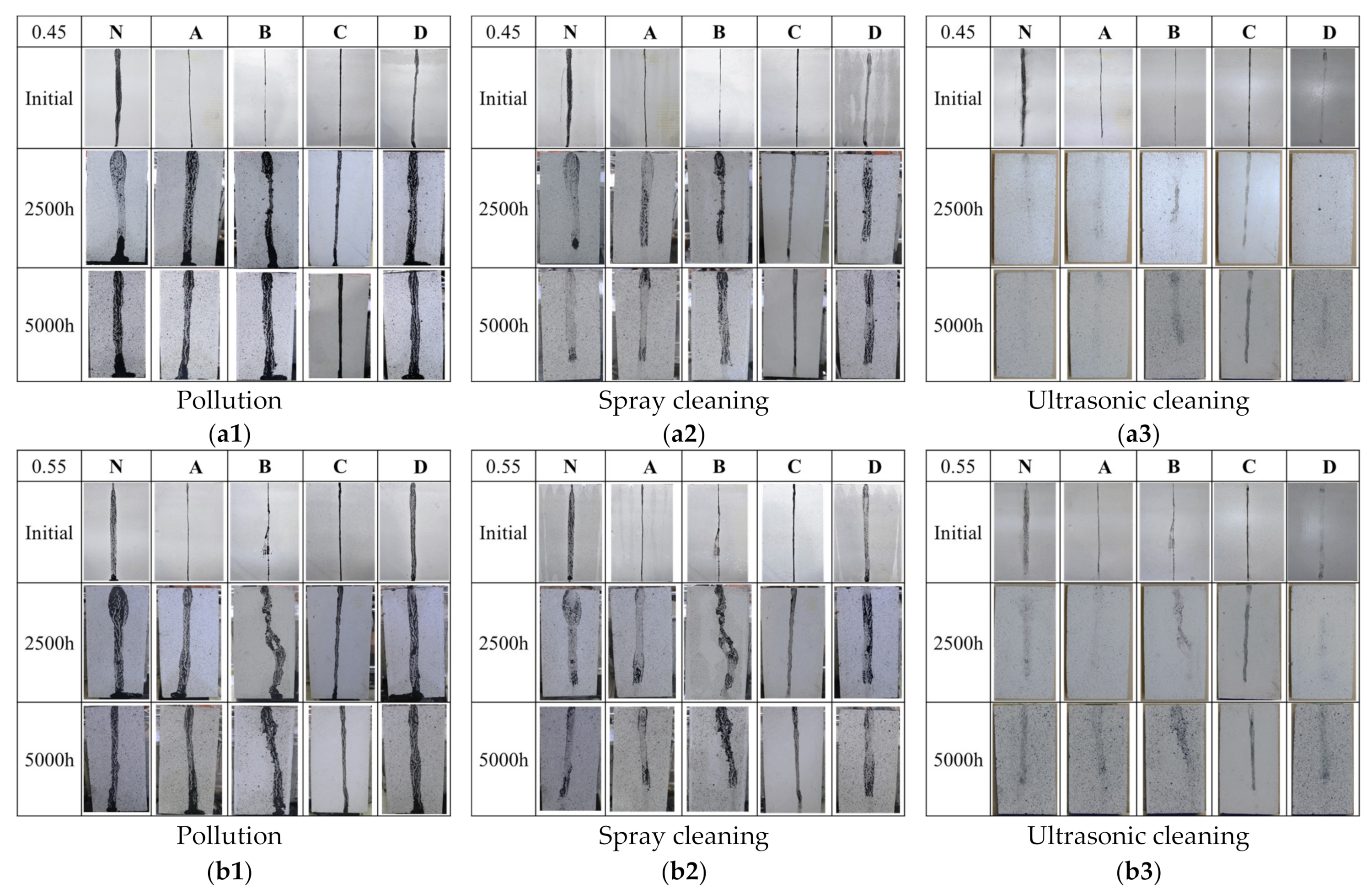

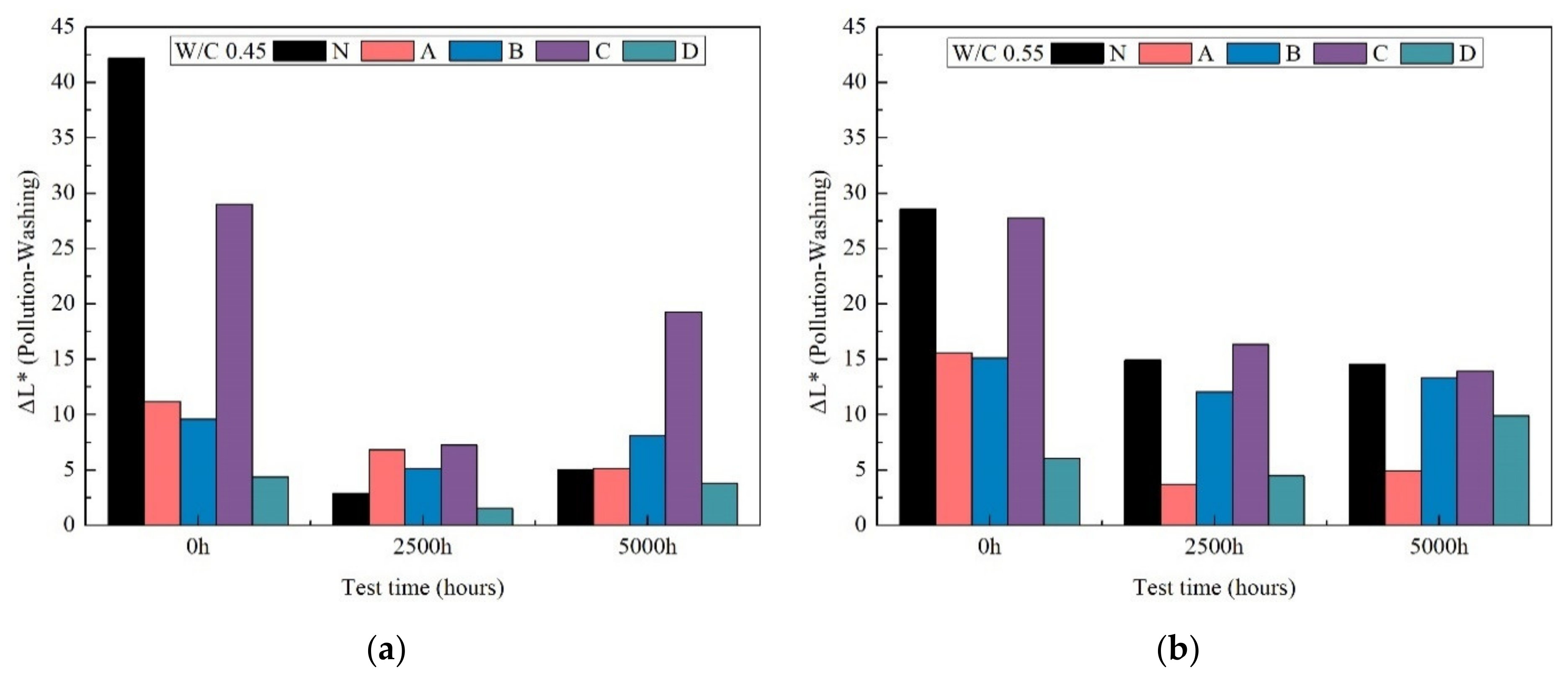
| Water Cement Ratio | Cement | Flow | Air Content | Material Content (kg/m3) | ||
|---|---|---|---|---|---|---|
| w/c | (mm) | (%) | W | C | S | |
| 0.45 | white Portland cement | 200 | 3.0 | 228 | 415 | 1606 |
| 0.55 | 228 | 508 | 1525 | |||
| Types and Symbol | N | A | B | C | D | |||||
|---|---|---|---|---|---|---|---|---|---|---|
| Un-Coated | Silane1 | Silane2 | Fluor-Resin | Silicate | ||||||
| Coating procedure | First coating | - | - | - | - | - | water-based water repellent | 200 g/m2 | - | - |
| Curing time | - | - | - | - | - | More than 16 h | - | - | ||
| Medium coating | - | - | - | - | - | Fluor-resin | 100 g/m2 | - | - | |
| Curing time | - | - | - | - | - | More than 3 h | - | - | ||
| Top coating | - | Silane | 200 g/m2 | Silane | 200 g/m2 | Fluor-resin | 100 g/m2 | Aqueous silicate | 250 g/m2 | |
| Curing time | - | More than 4 h | More than 6 h | More than 24 h | 24 h | |||||
| Time | Temperature | Black Panel Temperature | Relative Humidity | Irradiance | |
|---|---|---|---|---|---|
| min | °C | °C | % | (W/m2) | |
| Wetting | 18 | 38 | - | 95 | 60 |
| Drying | 102 | - | 63 ± 2 | 50 (40–60) | 60 |
| Grade | Appearance Change |
|---|---|
| 0 | No change (i.e., there is no change to be observed.) |
| 1 | Very small (i.e., barely observed change.) |
| 2 | A slight (i.e., a clearly observed change.) |
| 3 | Medium (i.e., a very clearly observed change.) |
| 4 | Critical (i.e., substantial change.) |
| 5 | Very marked change |
Publisher’s Note: MDPI stays neutral with regard to jurisdictional claims in published maps and institutional affiliations. |
© 2021 by the authors. Licensee MDPI, Basel, Switzerland. This article is an open access article distributed under the terms and conditions of the Creative Commons Attribution (CC BY) license (https://creativecommons.org/licenses/by/4.0/).
Share and Cite
Chen, F.; Quy, N.X.; Kim, J.; Hama, Y. Investigation on Aesthetic and Water Permeability of Surface Protective Material under Accelerated Weathering. Materials 2021, 14, 6896. https://doi.org/10.3390/ma14226896
Chen F, Quy NX, Kim J, Hama Y. Investigation on Aesthetic and Water Permeability of Surface Protective Material under Accelerated Weathering. Materials. 2021; 14(22):6896. https://doi.org/10.3390/ma14226896
Chicago/Turabian StyleChen, Feng, Nguyen Xuan Quy, Jihoon Kim, and Yukio Hama. 2021. "Investigation on Aesthetic and Water Permeability of Surface Protective Material under Accelerated Weathering" Materials 14, no. 22: 6896. https://doi.org/10.3390/ma14226896
APA StyleChen, F., Quy, N. X., Kim, J., & Hama, Y. (2021). Investigation on Aesthetic and Water Permeability of Surface Protective Material under Accelerated Weathering. Materials, 14(22), 6896. https://doi.org/10.3390/ma14226896






